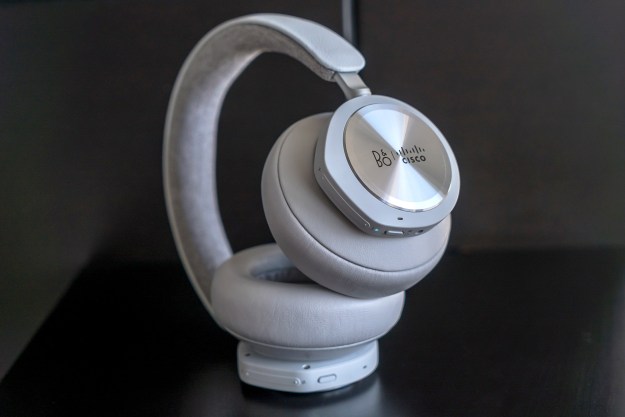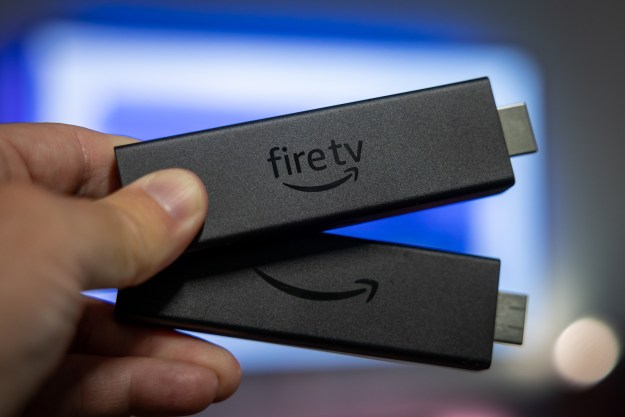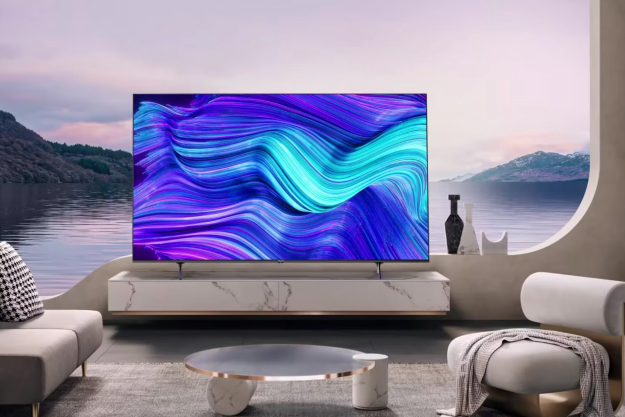
“Bang & Olufsen and Cisco partner to make conferencing clearer and more secure.”
- Excellent design
- Superb audio quality
- Webex integration
- Comfortable fit
- Good battery life
- Integration doesn't extend to other apps
- Expensive
- Overkill for noncorporate use
Is there a need for a pair of high-end headphones when working in the office (or simply working on office tasks)? Bang & Olufsen (B&O) and Cisco think so, and that’s why they came together to craft a pair of cans that are as much about conference calls as they are about your favorite tunes.
On the surface, this would seem an odd marriage. While Bang & Olufsen is certainly renowned for its sonic chops, Cisco’s reputation rests almost entirely on its networking expertise — not exactly the kind of company you’d expect to be involved in a personal audio device. So what makes the Bang & Olufsen Cisco 980 headphones special, and why do both B&O and Cisco say they were developed for the hybrid workforce? Let’s check them out.
What’s in the box?
Opening the box reveals the protective clamshell case, the headphones, and accessories. The case, with its fabric cover and semi-hard shell beneath, has a classy look, and the two company logos on the front remind you they’re not just your garden variety B&O cans (as if there were such a thing). There’s a flap within the case housing the 3.5mm line-in cable, USB-C charging cable, and a wireless USB-A adapter. A welcome sheet also includes a QR code to download the Bang & Olufsen app, which is where you’ll find the user manual.
Design

Does it make sense to use a full-size set of over-ear cans for conference calls? When you consider that most people can make do just fine with a basic set of wireless earbuds — which also happen to be way less bulky and obvious while on a video call — it makes you wonder who these are for. The answer, at least as far as the Cisco/B&O partnership is concerned, is that the 980s are supposed to bring together business-grade communications with outstanding sound. In other words, you get the kind of clarity, integration, and management you’d expect from a Cisco headset, only packed into a pair of B&O cans. Fair enough.
If you do like the premise behind the B&O Cisco 980, you will almost certainly appreciate the thought both brands put into the design. Some of it is clearly inspired by the Beoplay HX, where the earcups and headband use the same form and materials. They just don’t have the same articulating arms. The headband uses a fabric cushion topped with leather that falls nicely toward the earcups and complements the whole package. Plush cushions feel comfortable without clamping too tightly on your ears. The brushed metal covers on the outside accent the cans — and again — clarify the collaboration as they are emblazoned with both company logos.
Both cans also twist to flatten the headphones for easy storage in the included case. You will also see that each side has its share of onboard controls. The right side has the power button that also doubles for Bluetooth pairing, plus a 3.5mm jack and USB-C charging port. The left has a mute-unmute button. As you might expect from
The included USB-A wireless adapter is prepaired with the headphones, making it a fast alternative to the usual pairing process when working with computers. It’s also very handy if your machine is one of those rare beasts that doesn’t have a Bluetooth connection of any kind.
Setup and the two apps

There are a few ways to use the B&O Cisco 980, and while I knew that vide conferencing was the key focus, I first paired them with both an iPhone and an Android phone. The reason was the Bang & Olufsen app, which I assumed (rightly) would be the best way to learn everything about them. Various features appeared front and center, while the product guide within the settings menu provided insight into what else they could do.
It’s also where I enabled firmware updates during testing, and came to understand the extent of how the ANC and Own Voice worked, given that they operate on adjustable sliders in the app, too. The learning curve on the music and audio side isn’t all that steep, and it’s clear this was the area B&O took care of.
The other app that matters here is Webex, for both mobile and desktop. Cisco’s conferencing software is a big reason why it joined with B&O to make these headphones and it serves something of a dual purpose. On the one hand, better sound quality on either end makes video calls sound more lively, and on the other, there’s an easy transition to talking to someone, no matter what other audio content you might be listening to. For instance, if a call comes in while you’re listening to music or a podcast, you only need to double-tap either earcup to answer. Not on Webex’s mobile app, though. In that case, you’d need to go to the app first and then take the call.
Certain Webex features will work on PCs and Macs, but not mobile devices. Mute sync is one example, where pressing the mute button on the headphones also mutes the computer. Pressing unmute on either the
Secure headphones?
If you’re thinking to yourself, “OK, so these are just like any premium set of
Embedded within the B&O Cisco 980 is Cisco enterprise hardware and software security. This technology, Cisco claims, keeps hackers from remotely or physically tampering with the headphones, while simultaneously giving IT administrators the ability to update the
For most folks, the idea of someone eavesdropping on your
If you’re really worried about wireless security, you can choose to use the included USB-A-to-USB-C cable as a digital audio connection to the headphones. If you do, you’ll be able to maintain two Bluetooth connections as well, giving you a completely secure link for your computer-based Teams or Webex calls, while letting you wirelessly stream music from your smartphone or tablet.
Sound quality

Since sound is supposed to set the B&O Cisco 980 apart from others in this context, it was worth looking into it more closely. As over-ear cans for music, podcasts, and audiobooks, they won’t disappointed. The sound signature has B&O written all over it. Crisp, clear, refined, they truly were a pleasure to enjoy good content. Bass is solid, mids are resonant, and highs stay warm throughout.
The B&O app helps further the cause with a solid EQ feature that gives you a handful of presets, plus the ability to create your own custom ones. The one drawback is that it’s not your quintessential EQ, meaning you move the needle where you want within four quadrants, not a more traditional set of bands. That’s not uncommon for headphones these days, but when you’re at a premium level like this, I can see some people not liking this sort of layout, subjective as it may be.
Crisp, clear, refined, and never too far across the spectrum, they truly were a pleasure to enjoy good content.
With ANC on, the headphones were fantastic. Excellent noise cancellation helped drown out the background and bring in more of the audio. With Transparency or Own Voice, which are both essentially the same concept, I could dial in as much of the background noise as I wanted to hear my surroundings or talk to someone. Own Voice takes it up a notch so you can almost feel like you’re not wearing
The earcups’ swipe gestures are surprisingly effective. Rather than just wildly swinging between volume levels or abruptly switching between ANC and Own Voice, sliding my finger up and down weaved through the settings smoothly.

Conferencing and phone calls
I waited to see if anyone I spoke to on video heard a difference and pointed it out first. That only happened once, when someone asked what headphones I was wearing, and upon answering, he mentioned that I was coming through clearer. In other cases, when I didn’t hear any comments about the sound, I would just outright ask for an honest opinion. No one ever complained or critiqued what they were hearing on their end, nor did I have any issues with how they were coming through.
Like with any videoconferencing app, Webex needs a good internet connection to not only make video look better, but to also pass through higher-quality sound. Assuming both sides of a call have good connections, the B&O Cisco 980 benefit from the consistency. What I appreciated even more was how good the microphones were at both picking up my voice clearly and drowning out background noises to keep it that way. If I was on calls for most of an average day, I would be very happy doing it while wearing the Cisco 980.
You won’t derive all of the same benefits when using other third-party conferencing apps. For example, I didn’t notice the same level of verbal performance with Zoom or Signal, and that’s largely by design. Cisco always intended to make the 980s sound better with its own software first. That’s not to say that audio suddenly reverts to some pedestrian state, just that the optimization isn’t necessarily there.
Battery life

B&O claims the headphones can last up to 24 hours per charge. That is mostly true, though it depends on volume level and connectivity. I found battery life held up better when using the USB adapter over standard Bluetooth, and I suspect it’s mainly because the connection is so steady. It’s not a drastic difference, mind you, but I noticed a slight improvement when checking on the app.
Our take
B&O and Cisco proved that the concept behind the 980 headphones works. The fact that they’re also only available through select channels, like directly from Cisco, makes clear that they made them for those who need something better for conferencing. The hefty $549 price tag clarifies that further. You would need to be an avid Webex user to get the most out of those features, otherwise you can get similar results with other cans.
Is there a better alternative?
With such a pricey proposition, it’s easy to look elsewhere for possible alternatives, even if you don’t get the same Webex integration. The Jabra Evolve2 85 are over-ears that include a pull-down boom mic and an LED “Busylight” to serve notice to others who might interrupt you. Jabra squeezed 10 microphones into these headphones, along with a slew of other features, at a cheaper $494 price tag.
The Sony WH-1000XM4 aren’t specific to the office, but they’ve proven themselves to be excellent for calls, and are easily among the best for sound quality currently available. Plus, they are considerably cheaper at $348. The same could be said for the Bose Noise Canceling Headphones 700, which also offer great sound, call quality, and comfort, and all for $379.
How long will it last?
These are quality headphones that should last a fairly long time. Keeping them in their case when you’re not using them should also help keep them going. You’re not going to wear these in adventurous situations, so water damage shouldn’t be something you run into. Bang & Olufsen and Cisco offer a standard one-year warranty to cover functional problems, but not physical damage.
Should you buy it?
Yes, if you’re an avid Webex user and you really want a mix of great audio and call quality. The Webex integration is the key here because it’s not something you will find with other headphones. Don’t spend the money if you aren’t going to use them half the time for calls.







